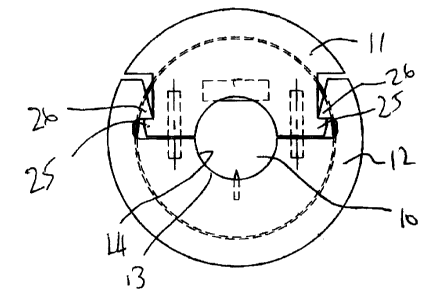Une partie des informations de ce site Web a été fournie par des sources externes. Le gouvernement du Canada n'assume aucune responsabilité concernant la précision, l'actualité ou la fiabilité des informations fournies par les sources externes. Les utilisateurs qui désirent employer cette information devraient consulter directement la source des informations. Le contenu fourni par les sources externes n'est pas assujetti aux exigences sur les langues officielles, la protection des renseignements personnels et l'accessibilité.
L'apparition de différences dans le texte et l'image des Revendications et de l'Abrégé dépend du moment auquel le document est publié. Les textes des Revendications et de l'Abrégé sont affichés :
| (12) Demande de brevet: | (11) CA 2474818 |
|---|---|
| (54) Titre français: | DISPOSITIF DE FIXATION |
| (54) Titre anglais: | CLAMPING DEVICE |
| Statut: | Morte |
| (51) Classification internationale des brevets (CIB): |
|
|---|---|
| (72) Inventeurs : |
|
| (73) Titulaires : |
|
| (71) Demandeurs : |
|
| (74) Agent: | BATTISON WILLIAMS DUPUIS |
| (74) Co-agent: | |
| (45) Délivré: | |
| (22) Date de dépôt: | 2004-07-16 |
| (41) Mise à la disponibilité du public: | 2006-01-16 |
| Licence disponible: | S.O. |
| (25) Langue des documents déposés: | Anglais |
| Traité de coopération en matière de brevets (PCT): | Non |
|---|
| (30) Données de priorité de la demande: | S.O. |
|---|
Désolé, les abrégés concernant le document de brevet no 2474818 sont introuvables.
Note : Les revendications sont présentées dans la langue officielle dans laquelle elles ont été soumises.
Note : Les descriptions sont présentées dans la langue officielle dans laquelle elles ont été soumises.

Pour une meilleure compréhension de l'état de la demande ou brevet qui figure sur cette page, la rubrique Mise en garde , et les descriptions de Brevet , États administratifs , Taxes périodiques et Historique des paiements devraient être consultées.
| Titre | Date |
|---|---|
| Date de délivrance prévu | Non disponible |
| (22) Dépôt | 2004-07-16 |
| (41) Mise à la disponibilité du public | 2006-01-16 |
| Demande morte | 2007-04-17 |
| Date d'abandonnement | Raison | Reinstatement Date |
|---|---|---|
| 2006-04-18 | Inachevé | |
| 2006-07-17 | Taxe périodique sur la demande impayée |
| Type de taxes | Anniversaire | Échéance | Montant payé | Date payée |
|---|---|---|---|---|
| Le dépôt d'une demande de brevet | 200,00 $ | 2004-07-16 |
Les titulaires actuels et antérieures au dossier sont affichés en ordre alphabétique.
| Titulaires actuels au dossier |
|---|
| PACAK, JOHN |
| Titulaires antérieures au dossier |
|---|
| S.O. |